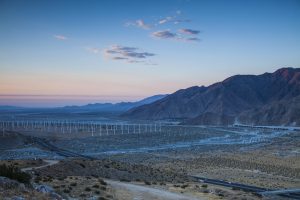 California is the second state after Hawaii to establish a 100% carbon-free energy goal for its electric grid. In late August, the state legislature passed Senate Bill 100 (SB 100) which created a 100% clean electricity standard by 2045 and also altered California’s current renewable portfolio standard (RPS). Previously, California’s RPS mandated 50% of the state’s retail electricity sales come from renewable sources by 2030, but following passage of SB 100, that figure is now modified to 60%.
California is the second state after Hawaii to establish a 100% carbon-free energy goal for its electric grid. In late August, the state legislature passed Senate Bill 100 (SB 100) which created a 100% clean electricity standard by 2045 and also altered California’s current renewable portfolio standard (RPS). Previously, California’s RPS mandated 50% of the state’s retail electricity sales come from renewable sources by 2030, but following passage of SB 100, that figure is now modified to 60%.
To achieve the 2045 goal, however, SB 100 takes a broader approach by explicitly instructing California’s energy agencies to “plan for 100% of total retail sales of electricity in California to come from eligible renewable energy resources and zero-carbon resources…” Qualifying zero-carbon sources include nuclear as well as natural gas with a carbon-capture system (CCS), so long as the CCS prevents the emission of any greenhouse gases.
Implementing California’s clean energy standard, however, raises questions regarding whether achieving 100% zero-carbon electric grid is feasible even with the inclusion of nuclear and natural gas facilities with CCS technology, particularly for two reasons:
- In 2016, PG&E announced it was closing Diablo Canyon by 2025, a nuclear generating facility in southern California responsible for producing almost 18,000 GWh annually of carbon-free electricity. California regulators voted to shutter Diablo Canyon in January 2018.
- No utility has demonstrated that CCS technology can successfully be scaled up to the levels SB 100 would require.
Under these circumstances, acquiring up to 40% of carbon-free electricity from scarcely available (nuclear) or unproven (CCS) sources of energy will be challenging. That said, California consistently leads the nation in solar energy installations. It is likely that renewable sources of energy will generate more than the 60% mandated by 2030, but it might still not be enough to achieve the state’s carbon-free mandate.
This discussion topic is based upon a false premise. The premise is that climate “scientists” have determined that a policy of reducing emissions of carbon dioxide has scientific support. The… Read more »
The goal is admirable, desirable and perhaps even critical. But to achieve it without a reliable, consistent base load capability — read nuclear — will be difficult. Even with some… Read more »
1) Is California’s timeline to reaching carbon neutrality realistic? Maybe. Californians for Green Nuclear Power, Inc. (CGNP) an independent 501(c)(3) that is an adverse intervenor before the California Public Utilities… Read more »
Without an unprecedented (for California) build-out of nuclear power plants there is no way that California will come anywhere close to zero by 2045. Charlatans who claim that the whole… Read more »
Many of the points made are only reasonable if the structure of the grid system we have developed and used over the past century remains the same. Trouble is the… Read more »
Dear Jane, You have presented another either/or argument. In your case it is either distributed energy sources or centralized energy sources. There are a number of other energy related either/or… Read more »
Herschel, the structural shift I tried to depict is not an either/or proposition. A central grid delivering electricity will still be with us, but the basic utility structure of large… Read more »
First of all, the title of this discussion paper is wrong. This error is excusable because the Act that California has passed also has an incorrect, if not misleading, title.… Read more »
Herschel Specter makes the critical point that California’s mandate of 100% clean electric power by 2045 is far from being sufficient in acting as a model for U.S. states and… Read more »
It is unlikely California will meet its low-carbon goals unless there is a revolution in thinking. From 2011 to 2017, the California average retail electricity prices rose from $13.1/kWh… Read more »
Germany comparison … be careful. Prices in Germany include a very large tax component so any comparison should remove that particular German cost. Secondly, from a mid 2017 .. “Germany’s… Read more »
Jane Twitmyer is correct that the German electricity rates include a massive tax that is partly responsible for the massive growth in retail electricity rates. However, that tax provides… Read more »
“The contribution from wind will shortly level off in Germany” … You are not considering offshore wind whose contributed to Germany’s power production mix reached 2.7 percent in 2017 when… Read more »
The value of added wind and solar drops as add more wind and solar to the grid. This is seen in the solar contribution as a percent of all… Read more »
Again .. offshore wind is different from onshore wind. First the wind blows stronger, blades can be larger – reaching a capacity of 40+% and going up, the farms are… Read more »
The contribution from wind will level off independent of how many more wind turbines Germany builds. The solar contribution in multiple European countries leveled off at less than 8%… Read more »
Evidently we can read the same articles and make different conclusions based on our initial perspective. Mine is success for keeping fossils in the ground and I do not understand… Read more »
There is a reality that many people do not fully understand—wind and solar are non-dispatchable electricity sources that produce no electricity at times of low wind or solar output. Beyond… Read more »